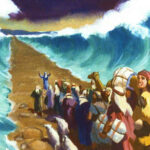How does a twenty-first century christian cope with reading the Old Testament, with all its brutality and difficult to believe stories?
Should we just grit our teeth and try to believe it’s all good? Or take the easy way out and dismiss it as fairy tales that have passed their use by date?
There is another, better way. We can take the Old Testament for what it is and still believe it is a revelation of “God’s true character” (as CS Lewis says). And be blessed and encouraged as we read it.
The obvious difficulties
We don’t have to read much of the Old Testament to find it’s a very challenging collection of books.
In the first few chapters we’re confronted with trees with the power to enhance or destroy human life, a talking snake and an account of the creation of the world and human beings that is at odds with science.
A few chapters on and we have mysterious beings that mate with human women, water covering the whole earth (even to the top of Everest?), a boat that contains pairs of every living creature (even platypus and koalas?) and a tower that reaches to heaven.
Then later on we see a God who is willing to kill every first born Egyptian, and order the killing of every resident of Canaan to make way for his chosen people.
As a christian who tries to follows the Jesus who taught us to love our enemies, how can I accept all this as truly from God?
Accepting the Old Testament for what it is
Christians read the Old Testament as divine revelation, and thus make assumptions about what it must, and must not be. And that is in large part what creates the difficulties.
But what if we put those assumptions aside and considered what it actually says and is?
Here are seven things I think we can know to be true about the Old Testament.
1. It was written in a different time and culture
It should go without saying that the various texts that make up the Old Testament were written down at a particular time, in a particular language by people who had a particular understanding of the world. Theirs was a low literacy, oral, pre-scientific culture. Even if we believe God dictated the words to the writers, he would still have had to use the language of the day.
It is very easy for us, who live in an educated, scientific, information-based culture to misunderstand and misinterpret these ancient writings. Somehow we need to be able to put our mindset to one side and see the Old Testament (as much as possible) through ancient Israelite eyes.
Scholars can help us here. They have found that many aspects of the Old Testament bear similarities to writings from other ancient Middle Eastern cultures. Stories like the creation and the flood, and law codes like the Ten Commandments, have similarities to Babylonian and Akkadian legends and writings, so we can see the Old Testament accounts in that light.
But there are some important differences too. For example, the Old Testament is monotheistic, or at least monolatrous, whereas the surrounding cultures were polytheistic. These differences help us see the Israelite authors’ purposes – to show Yahweh bringing order out of chaos, rather than the more chaotic actions of the gods of other cultures, and God creating the world for our benefit, rather than the gods creating humans to serve them..
2. It is old covenant
Jesus said he was bringing a new covenant that was fulfilling and replacing the old covenant described in the Old Testament (Luke 22:20, 16:16). The old covenant no longer applies for us (Hebrews 8:13). Many of the parts of the Old Testament we find hard to believe are truly from God (e.g. Psalm 137:9, Leviticus 20:27) are thus superseded by the revelation in Jesus.
The New Testament shows the apostles re-interpreting parts of the Old Testament law (Acts 10-11 & 15). Paul says quite explicitly that we are to follow the Spirit and not the letter of the law (2 Corinthians 3:6, Romans 7:6). We don’t have to hold onto the Old Testament Law.
3. It was an unfolding revelation.
There is a clear progression in the Old Testament. CS Lewis wrote that the early parts are mostly legendary, whereas the later parts are more historical. And, he said, the early parts of the Old Testament are a revelation of God’s power and the fact he is the one supreme creator God. Later the revelation moves on to stress justice, mercy and love.
We can see this in the fact that sometimes the prophets correct, or change or extend some teachings in the Law. And we can see Jesus doing the same (e.g. Matthew 5).
The Old Testament records the Israelites’ journey of a growing understanding of God as his revelation came to them. This appears to be the way God chose to do it. So some of what was written reflects that incomplete understanding.
4. It was written to make a point, not just to record events.
In the ancient world, very few people wrote history without some agenda. The Old Testament authors certainly had an agenda. Some of their big themes were:
- Yahweh created the world for a purpose;
- Israel as God’s chosen people;
- the Israelites’ “right” to the Promised Land;
- only Yahweh is worthy of worship.
The authors used various genres of literature to make their points – history, legend (or “mythicised history”), saga, poetry, prophecy, proverbs, stories, parables, etc. We make a mistake if we read a non-historical writing as if it is history, and miss the main point.
5. It contains more than one perspective
The writers of the various Old Testament books have different backgrounds and different emphases; for example they might be prophet, or priest, or from the royal court. And they wrote at different times, or recorded stories handed down from earlier times, and so had differing degrees of God’s revelation.
It is therefore not surprising that they have different perspectives, different emphases and different purposes. The compilers of the Old Testament apparently wanted to preserve all their traditions, and didn’t seem to have a problem with different viewpoints. Some scholars say the Old Testament is like a discussion between different viewpoints.
6. It isn’t always literal and factual
Thus we can safely conclude that the Old Testament isn’t always factual, and shouldn’t always be read literally. That is the nature of the book God has given us, and we should accept it for what it is.
If this seems like a radical conclusion, consider this. The rabbis of the time interpreted their scriptures in very fluid ways, and Jesus and the apostles follow them in this :
Sometimes they give passages very different meanings
- In John 10:35, Jesus quotes Psalm 86 to make a very different point to what the Psalmist was making;
- when Paul quotes Psalm 68 in Ephesians 4:8, he changes the wording to mean the opposite of the original.
Sometimes they take a passage completely out of context
- Matthew 1:23 takes a prophecy in Isaiah 7:14 out of its original context of reassuring the king about coming events, and turns it into a prophecy of Jesus’ virgin birth;
- Matthew 27:9-10 quotes Zechariah 11:12 but changes the story into a prophecy of Judas’ betrayal.
Sometimes they omit sections of OT passages that were not true
- In Luke 4:18-19 Jesus omits one section of an Isaiah passage, which is about vengeance;
- Three times in Romans (Romans 15:9-10, 12:19-21 and 3:10-18) Paul omits or changes Old Testament quotes to remove references to God’s vengeance.
So on the authority of Jesus, Paul and the gospel authors, we don’t necessarily have to take everything in the Old Testament as literal and factual history, and we can consider other options to interpret the Old Testament.
So how to read the Old Testament?
With all this in mind, we can now see some principles that will help us read the Old Testament faithfully.
1. Jesus is the ultimate revelation of God
Jesus shows us what God is like better than anything else does (Colossians 1:16-19, Hebrews 1:1-3). In the New Testament we learn that God is love (1 John 4:8), and Jesus’ actions and teachings show us that love in living form.
We should therefore question any understanding of the Old Testament that doesn’t conform to what we know about Jesus from the New Testament. If God appears to be behaving differently than we know Jesus behaved, then we should reconsider whether we should accept that OT understanding.
So we should read the Old Testament through the lens of Jesus and the character of God who is love.
2. What was the author’s purpose?
We should be asking ourselves what was the author wanting us to know? What are the big ideas being expressed? It may not be helpful to worry so much about “did it actually happen?”
3. How does the passage fit in?
The Old Testament tells a vast story of God preparing the way for the coming of Jesus. The revelation of God’s character and purposes unfolds over centuries.
We should therefore assess the place of any passage or book we are reading.
- Does it show God with the same character we see in Jesus? Then we can learn from that.
- Does it give us background which helps us understand Jesus and the New Testament? So much of what happens in Jesus’ ministry only make sense if we understand the Old Testament background.
- Does it show God at work in a different culture, time and covenant, teaching us about his character even though his purposes may be different in the new covenant?
- Does it show Jewish beliefs in an early stage in their formation? The revelation of God at that time may have been incomplete, but we can still learn from it. Stories, whether fully historical or not, may still teach us about human nature and God’s response. Or at least teach us about God’s people before they were following his ways.
Considering these different ways to understand Old Testament passages will help us decide how to interpret the passage and what we can learn from it for today.
4. Learn from the positive
There are many positive and helpful pictures of God in the Old Testament where his character is shown to be similar to what we see in Jesus. The problematic passages are in the minority. So we can legitimately focus on the positive passages on the basis that the problematic ones are based on an incomplete understanding.
5. Read it over and over again
Critics can characterise the Old Testament as the writings of primitive goat herders, but in reality these writings are quite sophisticated, with layers of meaning and concepts that may not be obvious at first reading. We shouldn’t expect to “get it” the first time we read it, or even subsequent times.
The Bible was made to be re-read and considered, sometimes even meditated on.
6. Recognise themes and metaphors
There are recurring themes and metaphors in the Old Testament, and into the New.
For example, the oceans were seen as chaotic and dangerous, and so can often symbolise or represent forces opposing God and threatening his people. This theme appears throughout the whole Bible:
- God separated the land from the water in Genesis 1, showing him giving humans a safe place out of chaos.
- The chaos of the flood destroyed the evil world, but God provided Noah with a way to ride out the chaos.
- Moses led the Israelites through the chaos of the Red Sea, which threatened to be the scene of tragedy, and instead destroyed the Egyptians in it.
- Several Psalms (e.g. 74:13-14, 107:29) and other passages (e.g. Jeremiah 5:22, Isaiah 17:12-13) portray the sea as chaotic and opposed to God.
- Jesus shows his power to frightened disciples by calming the sea (Mark 4:35-41).
- And finally, in the new heaven and the new earth (Revelation 21:1) there will no longer be any sea – God has conquered and there will be peace, not chaos.
Other themes often used symbolically as well as literally include the Exodus (Matthew 2:14-15 likens Mary and Joseph taking the baby Jesus to Egypt to the Exodus), personifying wisdom (e.g. Proverbs 1:20-21, Matthew 11:19) and exile (1 Chronicles 5:26, 1 Peter 1:1).
We can read the Old Testament without knowing anything of these symbols and themes, but we will miss some of the richness and will likely totally misunderstand some passages.
The kingdom of God
One of the most important themes in the entire Bible is the kingdom of God. Historically, the nation of Israel reached its political peak in the reigns of kings David and Solomon about a millennium before Jesus. When the Jews became victims of the superpowers Assyria, Babylon and Egypt, and lost their freedom and autonomy, and eventually lost their nation, city and temple, they looked back with longing to this time.
Their hope became a new king, a Messiah, who would re-establish their nation. Isaiah 9:6-7 expresses this hope in the famous words:
For to us a child is born,
to us a son is given,
and the government will be on his shoulders.
And he will be called
Wonderful Counselor, Mighty God,
Everlasting Father, Prince of Peace.
Of the greatness of his government and peace
there will be no end.
He will reign on David’s throne
and over his kingdom
Jesus and the gospel writers pick up on this theme. Jesus announces his ministry (Mark 1:14-15) and carries it on (Luke 4:43) as the establishment of the kingdom or reign of God on earth. If we don’t understand the central place of the kingdom of God in Jesus’ ministry, we miss an enormous amount of what he was saying and doing. Unfortunately, too many churches miss this emphasis.
7. The Holy Spirit is our friend
Jesus promised God’s Spirit would lead us into truth (John 16:13-15). So if we read the Old Testament with these thoughts in mind, and praying for the Spirit’s guidance, we will hopefully be able to look past the problematic parts and find it edifying and informative.
Happy reading!
So reading the Old Testament can be an informative and helpful part of our lives as followers of Jesus. We can put the difficult sections in context. Most importantly, we can better understand Jewish thought and the life and teachings of Jesus.
Happy (= blessed) reading!
Photo by Joel Muniz on Unsplash




